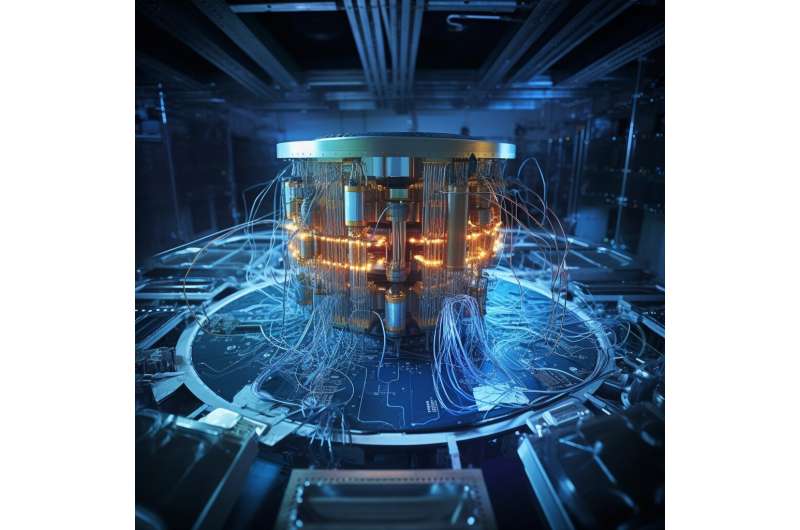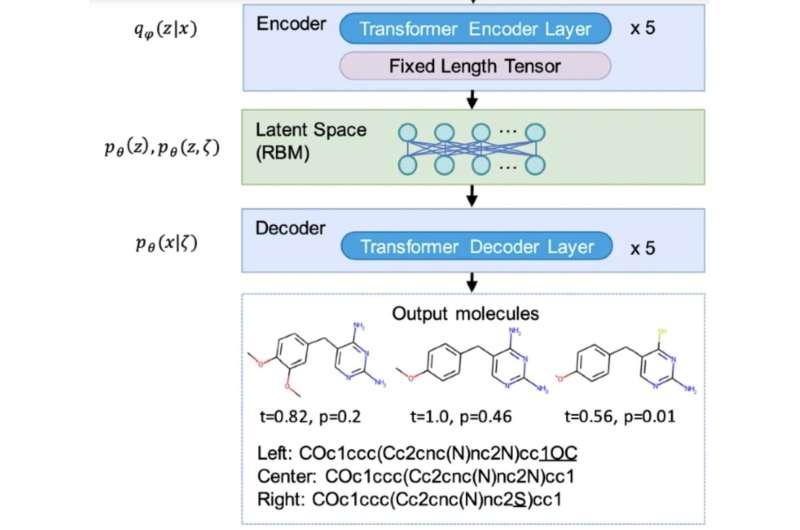This article has been reviewed according to Science X's editorial process and policies. Editors have highlighted the following attributes while ensuring the content's credibility:
fact-checked
peer-reviewed publication
proofread
Researchers demonstrate the power of quantum computing in drug design

Gero, an AI-driven biotech focused on aging and longevity, has demonstrated the feasibility of applying quantum computing for drug design and generative chemistry, which now offers significant promise for the future of healthcare. The research, published in Scientific Reports, outlines how a hybrid quantum-classical machine-learning model was used to interface between classical and quantum computational devices with the goal of generating novel chemical structures for potential drugs—an industry first.
The research paper follows in the wake of recent advancements from Gero, which sparked vigorous discussion among longevity experts in the scientific community when a story was published in Popular Mechanics that asserted humans can stop—but not fully reverse—aging. Earlier this year, Gero announced a target discovery deal with Pfizer, whereby Gero's machine-learning technology platform is being applied to discover potential therapeutic targets for fibrotic diseases using large-scale human data.
In this new line of research, the team explored whether a hybrid generative AI system—a deep neural network working in conjunction with commercially available quantum hardware—could suggest unique chemical structures that are synthetically feasible and possess drug-like properties.
The need for new computational approaches
The vast structural space of all possible drug-like molecules presents a monumental challenge in drug discovery. The number of realistic drug-like molecules is estimated to be between 1023 and 1060—and only about 108 substances have ever been synthesized.
This untapped molecular landscape could hold the keys to future game-changing treatments for currently incurable age-related diseases and aging itself. However, the size and complexity of this uncharted chemical diversity space requires innovative tools for the selection of novel, biologically active and, at the same time, synthetically accessible molecules waiting to be turned into future drugs.
"These breakthroughs pave the way for a dramatic acceleration of the drug discovery process," said Peter Fedichev, CEO of Gero.
"Drug design operates at the intersection of the realms of classical and quantum phenomena, and requires simultaneous determination of quantum properties of drug-like molecules and their effects on living systems described by classical physics. This is why quantum computing will significantly augment our capacity to develop transformative treatments for the most challenging diseases and conditions, including aging itself."
A team of researchers with wide-ranging expertise
The research team comprises leading experts in diverse fields, encompassing physics, modern machine learning, generative models, quantum physics, and drug design. As documented in the paper, Hybrid quantum-classical machine learning for generative chemistry and drug design, the researchers developed a hybrid model that combines a compact discrete variational autoencoder (DVAE, a generative chemistry algorithm) in a form that can run on an existing state-of-the-art quantum device called a D-Wave quantum annealer.
The proposed system is a hybrid quantum/classical generative mode trained to sample from the distribution of drug-like and synthetically available molecules. Once the training was complete, the system could be run in the generative mode and suggested 2,331 novel chemical structures with properties typical for biologically active compounds. Encouragingly, less than 1% of the generated molecules had a high similarity to any molecule in the training set, indicating a high level of novelty in the generated compounds.
Realizing the potential of quantum computing in drug discovery
The development of quantum algorithms and hybrid quantum-classical machine-learning models for drug discovery could significantly advance the field of medicinal chemistry. Because the vastness of the structural space of possible drug-like molecules poses a significant challenge for classical computing, quantum computing may offer a much more efficient approach.
Molecules are archetypical quantum objects and hence quantum computers are naturally suited for solving complex quantum chemistry problems. And, based on the results from the scientific study, the team is now convinced that quantum algorithms can enhance machine learning in drug design—and could potentially evolve into ultimate generative chemistry algorithms.
As quantum hardware matures, specific components of the network could be converted into their fully quantum counterpart, potentially transforming the system into a Quantum VAE (QVAE) that could sample from richer, non-classical distributions. This could ultimately speed up the training of the system, potentially making quantum-enhanced generative models more efficient for drug-design applications.
"In this study, using a quantum computer, we explored an entirely new dimension in chemical space and opened a door to an entirely new room," said Alexey Fedorov, head of the RQC research team that co-authored the paper with Gero.
"As quantum computers become even more powerful, we expect that they will become more and more helpful in various studies, especially in the machine-learning domain applied to naturally quantum mechanical problems. In the next five to ten years, we will see a new generation of drugs and materials created with the help of quantum computers."

As documented in Scientific Reports, the research established two important conclusions:
1. Hybrid quantum-classical machine learning has excellent potential for drug-discovery applications. The researchers demonstrated that it is feasible to use hybrid architectures that combine quantum computers with deep classical networks for drug-discovery applications. They built a compact and yet sufficiently powerful model, small enough to fit on a state-of-the-art D-Wave quantum annealer and trained this model on a subset of the ChEMBL dataset of biologically active compounds.
2. We can generate novel chemical structures using a commercially available quantum machine. The hybrid quantum-classical model generated 2,331 novel chemical structures with medicinal chemistry and synthetic accessibility properties in the ranges typical for biologically active molecules from the ChEMBL dataset. Importantly, the quantum computer used to perform the calculations is available as cloud computing infrastructure.
What this means for drug discovery
Further develop quantum machine-learning models. The scientific report demonstrated that a hybrid quantum-classical machine learning model can generate novel drug-like molecules. The next step is to further develop and refine these models. This includes enhancing the generative capabilities of the model to generate more diverse and novel molecules and optimizing the efficiency of the models.
Transition to full quantum models. The researchers used a hybrid quantum-classical model as a stepping stone towards fully quantum generative models. As quantum hardware matures, the Restricted Boltzmann Machine (RBM) used in the study could be transformed into a Quantum Boltzmann Machine (QBM), and the whole system might be transformed into a Quantum Variational Autoencoder (QVAE) that could sample from potentially richer non-classical distributions.
For actual drug design, the models should be able to predict additional properties, such as the binding constant to a specific target, on top of generating novel compounds. This would allow for the generation of compounds designed to bind specific medically relevant targets.
Quantum computing and drug discovery are complex fields that require expertise from many different areas. Collaborations between quantum computing experts, pharmaceutical companies, and medical researchers would be beneficial in moving the field forward.
Fedichev sees enormous promise for the application of quantum computing to address lifespan and healthspan:
"Our goal is to slow down or even stop human aging. This is no small feat and will require intense effort and the fusion of probably yet unknown amounts of technology borrowing from the science of complex systems, modern AI and machine-learning technologies, vast biomedical datasets, and revolutionary bioengineering," he added.
"Recognizing the potential of quantum computing and quantum machine learning—a rapidly advancing field with immense promise—we have incorporated these into our arsenal, setting the stage for much-needed advancements in drug design against aging."
More information: A. I. Gircha et al, Hybrid quantum-classical machine learning for generative chemistry and drug design, Scientific Reports (2023). DOI: 10.1038/s41598-023-32703-4
Journal information: Scientific Reports
Provided by Gero




















